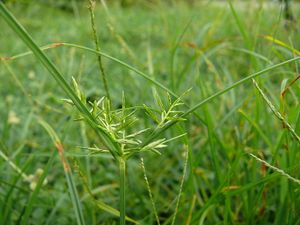Note: This is a project under development. The articles on this wiki are just being initiated and broadly incomplete. You can Help creating new pages.
Difference between revisions of "Cyperus rotundus - Mustaka"
m (Prabhakar moved page Musta to Musta (Cyperus rotundus)) |
m (Prabhakar moved page Musta (Cyperus rotundus) to Cyperus rotundus - Musta) |
(No difference)
| |
Revision as of 10:20, 23 April 2018
Cyperus rotundus is a perennial plant, that may reach a height of up to 140 cm (55 inches). The names "nut grass" and "nut sedge" – shared with the related species Cyperus esculentus – are derived from its tubers, that somewhat resemble nuts, although botanically they have nothing to do with nuts.The root system of a young plant initially forms white, fleshy rhizomes, up to 25 mm in dimension, in chains. Some rhizomes grow upward in the soil, then form a bulb-like structure from which new shoots and roots grow, and from the new roots, new rhizomes grow. Other rhizomes grow horizontally or downward, and form dark reddish-brown tubers or chains of tubers. It prefers dry conditions, but will tolerate moist soils, and often grows in wastelands and in crop fields.[1]
Cyperus rotundus improves lactation, relieves fever, burning sensation, excessive thirst. Commonly known as nut grass, it is also used in treating diarrhea, dyspepsia, herpes and more.
Common name
- English - Nut grass
- Kannada - ಕೋರನಾರಿ-ಗಡ್ಡೆ
- Hindi - बड़ा नागर मोथा
